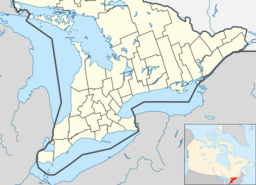Tay River (Ontario)
| Tay River | |
| River | |
| Country | Canada |
|---|---|
| Province | Ontario |
| Region | Eastern Ontario |
| County | Lanark |
| Part of | Saint Lawrence River drainage basin |
| Source | Bobs Lake |
| - location | Lanark Highlands |
| - elevation | 162 m (531 ft) |
| - coordinates | 44°45′34″N 76°31′21″W / 44.75944°N 76.52250°W |
| Mouth | Lower Rideau Lake, Rideau River |
| - location | Drummond/North Elmsley |
| - elevation | 125 m (410 ft) |
| - coordinates | 44°52′43″N 76°06′46″W / 44.87861°N 76.11278°WCoordinates: 44°52′43″N 76°06′46″W / 44.87861°N 76.11278°W |
| Length | 95 km (59 mi) |
| Basin | 850 km2 (328 sq mi) |
The Tay River is a river in Lanark County in Eastern Ontario, Canada. It is in the Saint Lawrence River drainage basin and is a left tributary of the Rideau River.
For a map showing the river course highlighted on a topographic map, see this reference.
This river starts at Bobs Lake and leaves the lake, controlled by a weir, near the community of Bolingbroke in geographic South Sherbrooke Township, part of the municipality of Tay Valley. It heads northeast, passes under Lanark County Road 36, reaches Christie Lake and passes there into geographic Bathurst Township. It continues northeast, passes under Lanark County Road 6, and divides into two channels; the right channel is known as Scotts Snye. The river then travels through the community of Glen Tay, continuing to Perth. The river splits into two main channels as it flows through downtown Perth. The two channels have recombined by the time it leaves Perth and continues to the Rideau River, which drains via the Ottawa River into the Saint Lawrence River.
The river is 95 kilometres (59 mi) in length and drains an area of 850 square kilometres (330 sq mi). A canal connects the river to the Tay Canal, and Rideau Canal systems at Beveridge Bay on Lower Rideau Lake.
A controversy erupted in 2002 when Swiss multinational OMYA applied for a permit to take up to 4,500 cubic metres (158,900 cu ft) of water per day from the river at its Glen Tay calcium carbonate plant. As a result, the permitted amount was reduced to 1,500 cubic metres (53,000 cu ft) per day, subject to review in 2008.
...
Wikipedia

